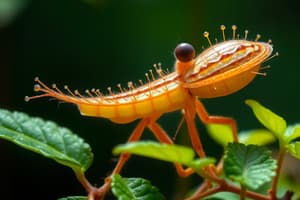Podcast
Questions and Answers
What is a significant aspect of jaiva vividata?
What is a significant aspect of jaiva vividata?
- Genetic modifications in organisms
- Interaction among members from different kingdoms (correct)
- Study of ecosystem dynamics
- Classification of all known organisms
Which branch of life sciences focuses on classifying organisms based on similarities using the Linnean system of taxonomy?
Which branch of life sciences focuses on classifying organisms based on similarities using the Linnean system of taxonomy?
- _Jaiva vividata_
- Environmental studies
- Systematics (correct)
- Ecological science
What are some essential services facilitated by cross-kingdom relationships mentioned in the text?
What are some essential services facilitated by cross-kingdom relationships mentioned in the text?
- Social networking services
- Mobile application development
- Nutrient cycling and decomposition (correct)
- Transportation services
Why is the Linnean system of taxonomy considered a standard framework?
Why is the Linnean system of taxonomy considered a standard framework?
What does studying the vastness of life's diverse manifestations help us appreciate?
What does studying the vastness of life's diverse manifestations help us appreciate?
Why does studying life's diverse expressions deserve our continued attention and curiosity?
Why does studying life's diverse expressions deserve our continued attention and curiosity?
What does 'jaiva vividata' refer to?
What does 'jaiva vividata' refer to?
How can 'jaiva vividata' be best appreciated?
How can 'jaiva vividata' be best appreciated?
Which ecosystems exemplify the diversity highlighted by 'jaiva vividata'?
Which ecosystems exemplify the diversity highlighted by 'jaiva vividata'?
What makes prokaryotes different from eukaryotes?
What makes prokaryotes different from eukaryotes?
Which characteristics define Archaea and Bacteria?
Which characteristics define Archaea and Bacteria?
Why are eukaryotes considered more complex than prokaryotes?
Why are eukaryotes considered more complex than prokaryotes?
Flashcards are hidden until you start studying
Study Notes
Exploring Life Science: Diversity of Living Organisms
Life science, often referred to as jīv vignāna in Sanskrit, is a vast interdisciplinary field dedicated to understanding living organisms. One of its most captivating aspects is the study of life's diversity – jaiva vividata. In this exploration, we will delve into various facets that make our planet so wonderfully diverse, revealing why biology remains such an exhilarating subject.
What Is Jaiva Vividata?
The term 'diversity' refers to the multitude and variety of living forms existing within nature, each with unique features adapted through evolutionary processes. These characteristics enable them to interact and thrive in their respective environment. A deeper appreciation for jaiva vividata emerges when one considers the staggering range of biological complexity. For instance, consider the countless species inhabiting only a single ecosystem like a rainforest or coral reef. Each has evolved distinct traits to cope with the challenges posed by these habitats.
Domains of Life
Living organisms can be broadly divided into three domains—Archaea, Bacteria, and Eukaryota. Archaea and bacteria comprise prokaryotes; they lack membrane-bound cellular structures called organelles and possess circular DNA. By contrast, eukaryotes feature cells equipped with linear chromosomes, organelles like mitochondria and chloroplasts, and more complex structure and organization compared to prokaryotic entities.
A significant aspect of jaiva vividata, particularly relevant in ecological contexts, lies in the array of interactions between members belonging to different kingdoms. Cross-kingdom relationships facilitate essential services, including pollination, seed dispersal, nutrient cycling, and decomposition, which prove crucial for maintaining balanced ecosystem dynamics.
Classification of Species
Systematics, another branch of life sciences, focuses on classifying all known organisms based on morphological, molecular, and genetic similarities using the Linnean system of taxonomy. This classification system devised in the eighteenth century continues to serve as a standard framework, although constant refinements have been made over time due to new knowledge and discoveries.
Understanding the vastness of life's diverse manifestations helps us appreciate the intricate web connecting every element in the natural world and fosters respect for Earth's delicate balance. As scientists continually uncover novel insights, humanity gains valuable lessons from the natural world, stimulating further innovation across industries spanning medicine, agriculture, engineering, and beyond. Therefore, studying the many fascinating expressions of life on Earth deserves our continued attention and curiosity!
Studying That Suits You
Use AI to generate personalized quizzes and flashcards to suit your learning preferences.





